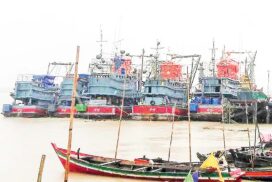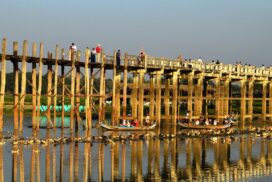Inlay Lake, nestled in Shan State, stands as a captivating haven for both local and international travellers, doubling as a significant habitat for migratory birds. Over time, it has evolved into a prominent tourist destination, drawing attention for its scenic beauty and biodiversity. However, the lake faces the imminent threat of shrinking due to silting caused by deforestation in its surrounding areas.
Once characterized by expansive shallow waters and a broad watershed, Inlay Lake has witnessed a steady reduction in size. To combat this ecological challenge, local authorities and residents are collaboratively engaging in annual conservation efforts. Heavy machinery is employed to counteract the effects of silting, ensuring the preservation of this vital natural resource.
With the lake serving as a vital source of livelihood for local people and contributing to national development, there is an essential need for conscientious efforts to ensure the sustainability of these resources. By doing so, the local populace can mitigate the impact of climate change on their region and contribute to the broader well-being of the nation.
Beyond its ecological significance, Inlay Lake plays a crucial role in sustaining the livelihoods of local communities. Residents cultivate crops on floating islands and along the bunds, yielding seasonal and kitchen crops that cater to daily consumption needs. Recognizing the lake’s importance, government departments, including the Department of Irrigation and Water Utilization Management, have initiated the Inlay Lake Conservation Project in the financial years.
For the 2023-24 fiscal year, a substantial budget of K700 million has been allocated for the construction of three silting-deterring dykes, removal of floating islands, dredging of sand and silt from the lake, and an anti-weeding process. The progress indicates that 40 per cent of silting-deterring dams, 78 per cent of dredging operations, 30 per cent of the anti-weeding process, and 54 per cent of floating island removal have been completed in the lake. Only upon the fulfilment of these project phases can the lake contribute positively to the environmental well-being of its surrounding areas.
Moreover, Inlay Lake plays a pivotal role in the national electrification plan, as Bilu Creek originates from the lake and streams to Lawpita, an excellent facility for generating electricity for the national grid. This underscores the lake’s significance in not only benefiting local communities but also contributing to the improvement of the overall natural environment.
With the lake serving as a vital source of livelihood for local people and contributing to national development, there is an essential need for conscientious efforts to ensure the sustainability of these resources. By doing so, the local populace can mitigate the impact of climate change on their region and contribute to the broader well-being of the nation.














